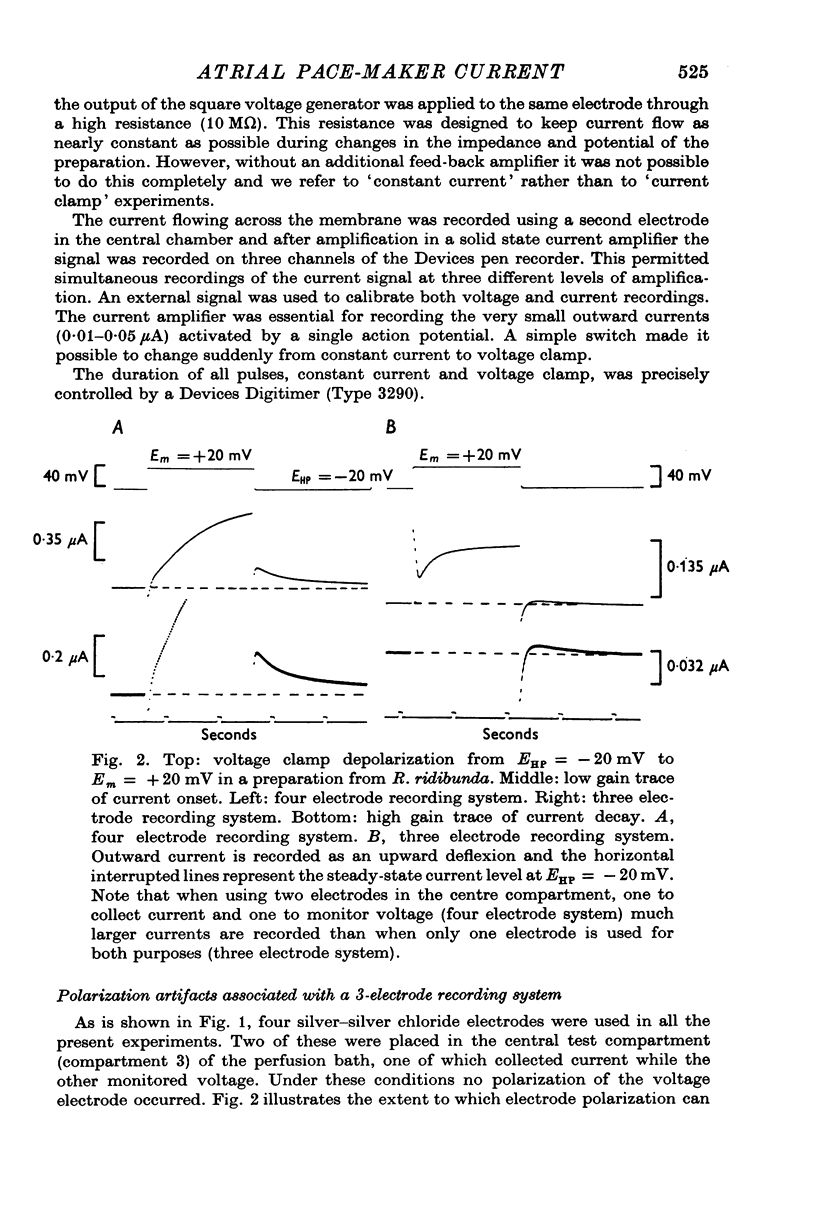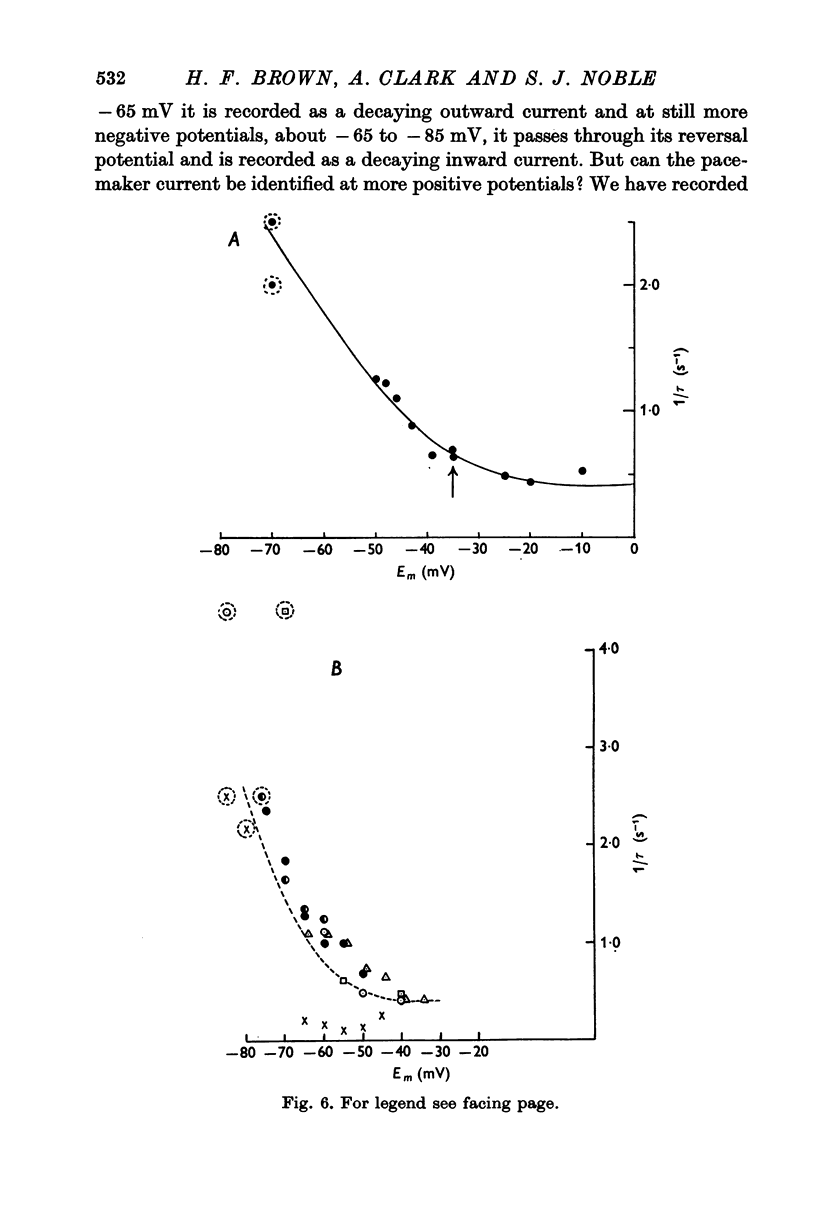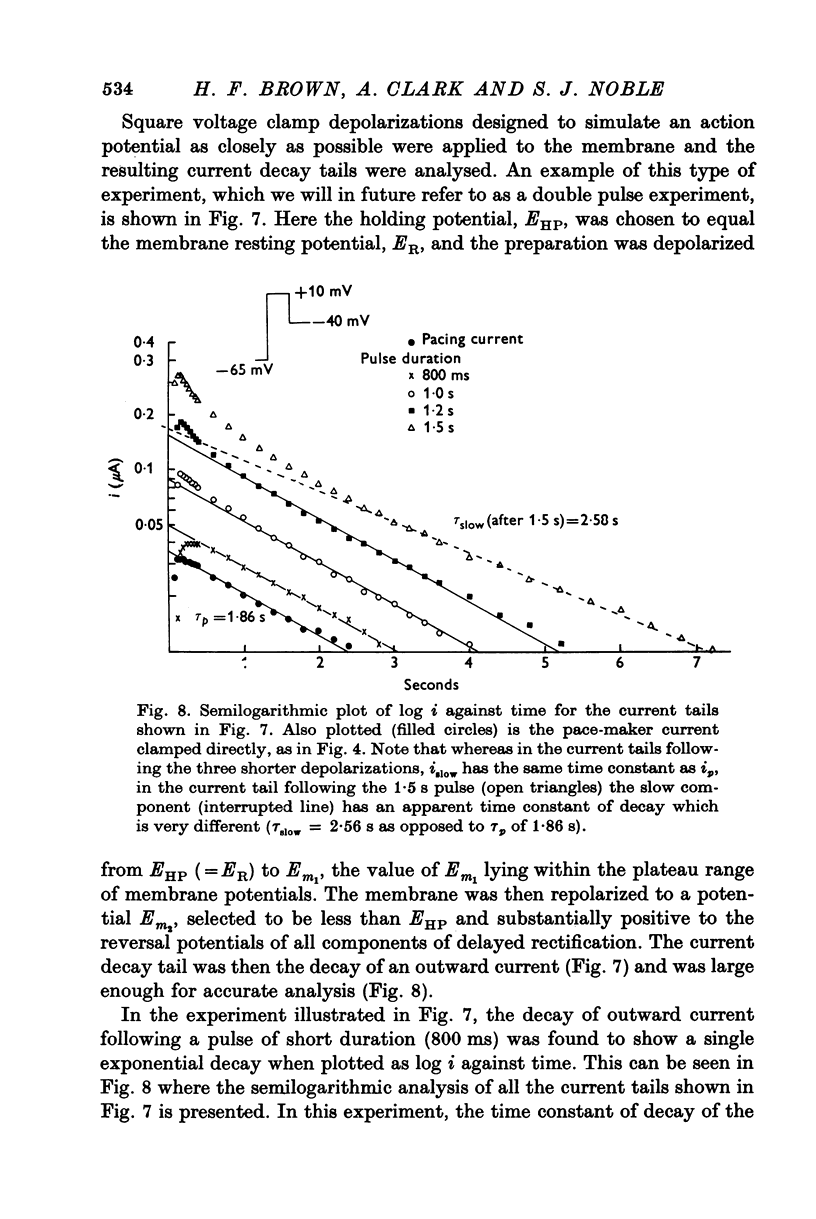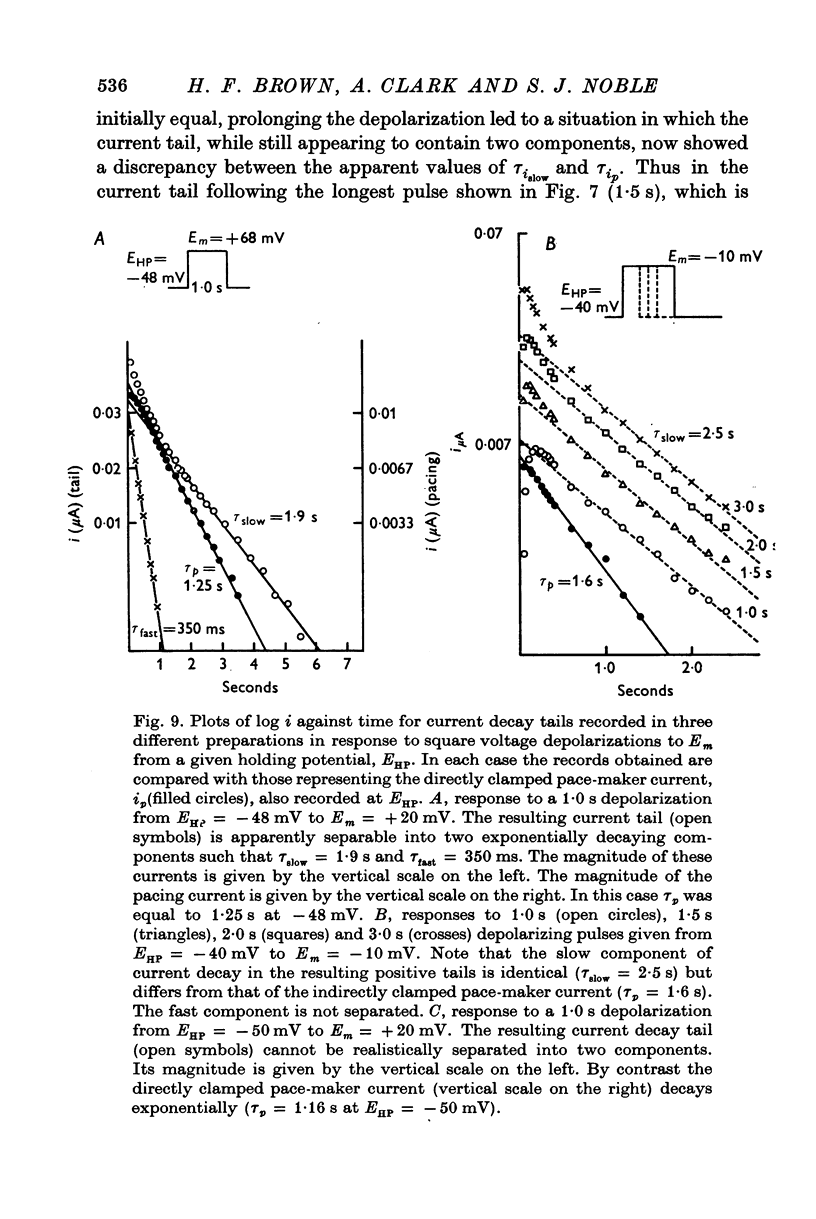Abstract
1. The nature and interactions of the membrane currents underlying induced pace-maker activity in frog atrial muscle have been investigated using a double sucrose gap technique. 2. The membrane current which controls the speed of the atrial pacemaker depolarization (the pace-maker current, ip), is shown to be an outward current activated within the plateau potential range of a normal action potential. The subsequent deactivation of ip at more negative potentials unmasks the depolarizing action of time-independent inward membrane currents so that a pace-maker potential can result. 3. The deactivation of ip over a limited potential range (between about -30 and -60 mV) can be reliably recorded by switching on the voltage clamp during an induced pace-maker depolarization. 4. Investigation of the time and voltage-dependent behaviour of ip over a much wider potential range is less straightforward. How ip can be separated from other components of outward current present in the decay tails following square voltage clamp depolarizations is described. 5. The majority of such current decay tails contain three components of outward current. It appears that two of these components, one of which is ip, are true Hodgkin-Huxley conductance systems chiefly carrying potassium ions. 6. The nature of the third current, which decays very slowly at moderate membrane potentials (about -40 mV), is discussed and reasons are briefly given for considering it to result from the accumulation of potassium ions in extracellular spaces. Preliminary evidence that potassium depletion occurs at potentials negative to the resting potential of the trabeculum is also presented. 7. Because of the obvious complexities involved, a quantitative analysis of the atrial outward currents is not attempted here but forms the subject of a following paper (Brown, Clark & Noble, 1976a).
Full text
PDF
























Selected References
These references are in PubMed. This may not be the complete list of references from this article.
- Baldwin K. M. The fine structure and electrophysiology of heart muscle cell injury. J Cell Biol. 1970 Sep;46(3):455–476. doi: 10.1083/jcb.46.3.455. [DOI] [PMC free article] [PubMed] [Google Scholar]
- Brown H. F., Clark A., Noble S. J. Analysis of pace-maker and repolarization currents in frog atrial muscle. J Physiol. 1976 Jul;258(3):547–577. doi: 10.1113/jphysiol.1976.sp011435. [DOI] [PMC free article] [PubMed] [Google Scholar]
- Brown H. F., Clark A., Noble S. J. Pacemaker current in frog atrium. Nat New Biol. 1972 Jan 5;235(53):30–31. doi: 10.1038/newbio235030a0. [DOI] [PubMed] [Google Scholar]
- Brown H. F., Noble D., Noble S. J. The influence of non-uniformity on the analysis of potassium currents in heart muscle. J Physiol. 1976 Jul;258(3):615–629. doi: 10.1113/jphysiol.1976.sp011437. [DOI] [PMC free article] [PubMed] [Google Scholar]
- Brown H. F., Noble S. J. A quantitative analysis of the slow component of delayed rectification in frog atrium. J Physiol. 1969 Oct;204(3):737–747. doi: 10.1113/jphysiol.1969.sp008941. [DOI] [PMC free article] [PubMed] [Google Scholar]
- Brown H. F., Noble S. J. Membrane currents underlying delayed rectification and pace-maker activity in frog atrial muscle. J Physiol. 1969 Oct;204(3):717–736. doi: 10.1113/jphysiol.1969.sp008940. [DOI] [PMC free article] [PubMed] [Google Scholar]
- Brown H. F., Noble S. J. Proceedings: Effects of adrenaline on membrane currents underlying pacemaker activity in frog atrial muscle. J Physiol. 1974 Apr;238(1):51P–53P. [PubMed] [Google Scholar]
- HAAS H. G., GLITSCH H. G., TRAUTWEIN W. [Sodium exchange in the atrium of the frog heart]. Pflugers Arch Gesamte Physiol Menschen Tiere. 1963;277:36–47. [PubMed] [Google Scholar]
- HODGKIN A. L., HUXLEY A. F. The components of membrane conductance in the giant axon of Loligo. J Physiol. 1952 Apr;116(4):473–496. doi: 10.1113/jphysiol.1952.sp004718. [DOI] [PMC free article] [PubMed] [Google Scholar]
- HUTTER O. F. Mode of action of autonomic transmitters on the heart. Br Med Bull. 1957 Sep;13(3):176–180. doi: 10.1093/oxfordjournals.bmb.a069609. [DOI] [PubMed] [Google Scholar]
- HUTTER O. F., TRAUTWEIN W. Vagal and sympathetic effects on the pacemaker fibers in the sinus venosus of the heart. J Gen Physiol. 1956 May 20;39(5):715–733. doi: 10.1085/jgp.39.5.715. [DOI] [PMC free article] [PubMed] [Google Scholar]
- Haas H. G., Glitsch H. G., Kern R. Kalium-Fluxe und Membranpotential am Froschvorhof in Abhängigkeit von der Kalium-Aussenkonzentration. Pflugers Arch Gesamte Physiol Menschen Tiere. 1966;288(1):43–64. [PubMed] [Google Scholar]
- Hauswirth O., Noble D., Tsien R. W. The mechanism of oscillatory activity at low membrane potentials in cardiac Purkinje fibres. J Physiol. 1969 Jan;200(1):255–265. doi: 10.1113/jphysiol.1969.sp008691. [DOI] [PMC free article] [PubMed] [Google Scholar]
- Izutsu K. T. Intracellular pH, H ion flux and H ion permeability coefficient in bullfrog toe muscle. J Physiol. 1972 Feb;221(1):15–27. doi: 10.1113/jphysiol.1972.sp009735. [DOI] [PMC free article] [PubMed] [Google Scholar]
- Lenfant J., Mironneau J., Aka J. K. Activité répétive de la fibre sino-auriculaire de grenouille: analyse des courants membranaires responsables de l'automatisme cardiaque. J Physiol (Paris) 1972;64(1):5–18. [PubMed] [Google Scholar]
- McGuigan J. A. Some limitations of the double sucrose gap, and its use in a study of the slow outward current in mammalian ventricular muscle. J Physiol. 1974 Aug;240(3):775–806. doi: 10.1113/jphysiol.1974.sp010634. [DOI] [PMC free article] [PubMed] [Google Scholar]
- Noble D., Tsien R. W. Outward membrane currents activated in the plateau range of potentials in cardiac Purkinje fibres. J Physiol. 1969 Jan;200(1):205–231. doi: 10.1113/jphysiol.1969.sp008689. [DOI] [PMC free article] [PubMed] [Google Scholar]
- Noble D., Tsien R. W. The kinetics and rectifier properties of the slow potassium current in cardiac Purkinje fibres. J Physiol. 1968 Mar;195(1):185–214. doi: 10.1113/jphysiol.1968.sp008454. [DOI] [PMC free article] [PubMed] [Google Scholar]
- Noble S. J. Potassium accumulation and depletion in frog atrial muscle. J Physiol. 1976 Jul;258(3):579–613. doi: 10.1113/jphysiol.1976.sp011436. [DOI] [PMC free article] [PubMed] [Google Scholar]
- Ojeda C., Rougier O. Kinetic analysis of the delayed outward currents in frog atrium. Existence of two types of preparation. J Physiol. 1974 May;239(1):51–73. doi: 10.1113/jphysiol.1974.sp010555. [DOI] [PMC free article] [PubMed] [Google Scholar]
- Reeves R. B. Role of body temperature in determining the acid-base state in vertebrates. Fed Proc. 1969 May-Jun;28(3):1204–1208. [PubMed] [Google Scholar]
- Rougier O., Vassort G., Stämpfli R. Voltage clamp experiments on frog atrial heart muscle fibres with the sucrose gap technique. Pflugers Arch Gesamte Physiol Menschen Tiere. 1968;301(2):91–108. doi: 10.1007/BF00362729. [DOI] [PubMed] [Google Scholar]
- Toda N. Influence of sodium ions on the membrane potential of the sino-atrial node in response to sympathetic nerve stimulation. J Physiol. 1968 Jun;196(3):677–691. doi: 10.1113/jphysiol.1968.sp008529. [DOI] [PMC free article] [PubMed] [Google Scholar]
- Vassalle M. Analysis of cardiac pacemaker potential using a "voltage clamp" technique. Am J Physiol. 1966 Jun;210(6):1335–1341. doi: 10.1152/ajplegacy.1966.210.6.1335. [DOI] [PubMed] [Google Scholar]
- Walker J. L., Ladle R. O. Frog heart intracellular potassium activities measured with potassium microelectrodes. Am J Physiol. 1973 Jul;225(1):263–267. doi: 10.1152/ajplegacy.1973.225.1.263. [DOI] [PubMed] [Google Scholar]


